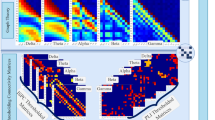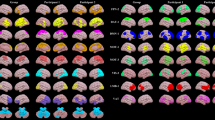Abstract
Autism Spectrum Disorder (ASD) and Attention Deficit Hyperactivity Disorder (ADHD) are neurodevelopmental conditions that manifest early in life, impacting cognitive, social, and behavioral functioning. ASD is characterized by difficulties in social interaction, communication challenges, and repetitive behaviors, whereas ADHD is distinguished by patterns of inattention, hyperactivity, and impulsivity. Early diagnosis of ASD and ADHD is crucial as it enables timely intervention and can significantly improve outcomes. Toward this goal, this research explores the potential of functional Magnetic Resonance Imaging (fMRI) to identify biological markers of ASD and ADHD through the analysis of functional connectivity in the brain. This work makes several important contributions. It successfully replicates and improves a state-of-the-art methodology, Contrast Subgraphs. In pursuit of simplification and efficiency using graph-theoretic approaches, an innovative technique called Discriminative Edges (DE) is introduced. DE not only achieves comparable accuracy but also offers significant improvements in speed and explainability. Furthermore, this study explores alternative methodologies, including the representation of graphs as tables for classification purposes. This technique demonstrates performance close to more intricate, cutting-edge methods. Further investigation into the incorporation of higher-order connectivity patterns reveals that such additions do not improve classification outcomes. Finally, our study using similarity measures sheds light on the challenges associated with classifying brain networks, highlighting the need for further research in this domain.
















Similar content being viewed by others
Data availability
We have used two datasets in this study. The ASD dataset obtained from Lanciano et al. (2020) is available at (https://github.com/tlancian/contrast-subgraph). The ADHD dataset from Abrate and Bonchi (2021) is available at (https://github.com/carlo-abrate/CounterfactualGraphs). The code and charts for our results for RQ1 and RQ2 can be found at https://github.com/keanelekenns/brain-network-classification. The code and charts for our results for RQ3-RQ5 can be found at https://github.com/sowbalas/HIBIBI2023.git.
References
APA (2013) Diagnostic and statistical manual of mental disorders: DSM-V. The American Psychiatric Association
Abbas H, Garberson F, Liu-Mayo S, Glover E, Wall DP (2020) Multi-modular AI approach to streamline autism diagnosis in young children. Sci Rep 10(1):1–8
Abrate C, Bonchi F (2021) Counterfactual graphs for explainable classification of brain networks. In: KDD, pp 2495–2504
Adriana Di Martino SM (2016) ABIDE. http://fcon 1000.projects.nitrc.org/indi/abide/abideI.html
Agarwal S, Raj A, Chowdhury A, Aich G, Chatterjee R, Ghosh K (2024) Investigating the impact of standard brain atlases and connectivity measures on the accuracy of ADHD detection from FMRI data using deep learning. Multimed Tools Appl, 1–35
Arbabshirani MR, Plis S, Sui J, Calhoun VD (2017) Single subject prediction of brain disorders in neuroimaging: promises and pitfalls. NeuroImage 145:137–165
Asan O, Bayrak AE, Choudhury A (2020) Artificial intelligence and human trust in healthcare: focus on clinicians. J Med Internet Res 22(6):15154
Bullmore E, Sporns O (2009) Complex brain networks: graph theoretical analysis of structural and functional systems. Nat Rev Neurosci 10(3):186–198
Cadena J, Vullikanti AK, Aggarwal CC (2016) On dense subgraphs in signed network streams. In: ICDM, pp 51–60. https://doi.org/10.1109/ICDM.2016.0016
CDC (2024) https://www.cdc.gov/ncbddd/autism/data.html
Consortium TA- (2012) The ADHD-200 Sample. Accessed: 2024-05-21. https://fcon 1000.projects.nitrc.org/indi/adhd200/
Coupette C, Dalleiger S, Vreeken J (2022) Differentially describing groups of graphs. In: Proceedings of AAAI conference on artificial intelligence, vol 36, no 4, pp 3959–3967
De Silva S, Dayarathna SU, Ariyarathne G, Meedeniya D, Jayarathna S (2021) FMRI feature extraction model for ADHD classification using convolutional neural network. Int J E-Health Med Commun (IJEHMC) 12(1):81–105
Elkan C (2012) Evaluating classifiers. UC San Diego
Enns K, Srinivasan V, Thomo A (2023) Identifying autism spectrum disorder using brain networks: challenges and insights. In: IISA, pp 1–8
Enticott PG, Kennedy HA, Rinehart NJ, Tonge BJ, Bradshaw JL, Taffe JR, Daskalakis ZJ, Fitzgerald PB (2012) Mirror neuron activity associated with social impairments but not age in autism spectrum disorder. Biol Psychiatry 71(5):427–433
Fischbach G (2007) Leo Kanner’s 1943 paper on autism. https://www.spectrumnews.org/opinion/viewpoint/leo-kanners-1943-paper-on-autism/
Gulhan PG, Ozmen G (2024) The use of FMRI regional analysis to automatically detect ADHD through a 3D CNN-based approach. J Imaging Informat Med. https://doi.org/10.1007/s10278-024-01189-5
Gutiérrez-Gómez L, Delvenne J-C (2019) Unsupervised network embeddings with node identity awareness. Appl Netw Sci 4(1):1–21
Hassan A, Sulaiman R, Abdulgabber M, Kahtan H (2021) Towards user-centric explanations for explainable models: a review. J Inf Syst Technol Manage 6:36–50. https://doi.org/10.35631/JISTM.622004
Hernandez LM, Rudie JD, Green SA, Bookheimer S, Dapretto M (2015) Neural signatures of autism spectrum disorders: insights into brain network dynamics. Neuropsychopharmacology 40(1):171–189
Hyman SL, Levy SE, Myers SM, Kuo DZ, Apkon S, Davidson LF, Ellerbeck KA, Foster JE, Noritz GH, Leppert MO, et al (2020) Identification, evaluation, and management of children with autism spectrum disorder. Pediatrics 145(1)
Jurman G, Visintainer R, Filosi M, Riccadonna S, Furlanello C (2015) The HIM glocal metric and kernel for network comparison and classification. In: DSAA, pp 1–10
Kautzky A, Vanicek T, Philippe C, Kranz G, Wadsak W, Mitterhauser M, Hartmann A, Hahn A, Hacker M, Rujescu D (2020) Machine learning classification of ADHD and HC by multimodal serotonergic data. Transl Psychiatry 10(1):104
Khaouid W, Barsky M, Srinivasan V, Thomo A (2015) K-core decomposition of large networks on a single pc. PVLDB 9(1):13–23
Khodatars M, Shoeibi A, Sadeghi D, Ghaasemi N, Jafari M, Moridian P, Khadem A, Alizadehsani R, Zare A, Kong Y, Khosravi A, Nahavandi S, Hussain S, Acharya UR, Berk M (2021) Deep learning for neuroimaging-based diagnosis and rehabilitation of autism spectrum disorder: a review. Comput Biol Med 139:104949–104949
Kong Y, Gao J, Xu Y, Pan Y, Wang J, Liu J (2019) Classification of autism spectrum disorder by combining brain connectivity and deep neural network classifier. Neurocomputing 324:63–68
Lanciano T, Bonchi F, Gionis A (2020) Explainable classification of brain networks via contrast subgraphs. In: KDD, pp 3308–3318
Lauritsen MB (2013) Autism spectrum disorders. Eur Child Adolesc Psychiatry 22:37–42
Linardatos P, Papastefanopoulos V, Kotsiantis S (2021) Explainable AI: a review of machine learning interpretability methods. Entropy 23(1):18
Liu Y, Xu L, Li J, Yu J, Yu X (2020) Attentional connectivity-based prediction of autism using heterogeneous RS-FMRI data from cc200 atlas. Exp Neurobiol 29(1):27–37
Loh HW, Ooi CP, Barua PD, Palmer EE, Molinari F, Acharya UR (2022) Automated detection of ADHD: Current trends and future perspective. Comput Biol Med 146:105525
Maximo JO, Cadena EJ, Kana RK (2014) The implications of brain connectivity in the neuropsychology of autism. Neuropsychol Rev 24(1):16–31
Miao B, Zhang L, Guan J, Meng Q, Zhang Y (2019) Classification of ADHD individuals and neurotypicals using reliable relief: a resting-state study. IEEE Access 7:62163–62171
Misman MF, Samah AA, Ezudin FA, Majid HA, Shah ZA, Hashim H, Harun M (2019) Classification of adults with autism spectrum disorder using deep neural network. In: AiDAS, pp 29–34
Mukherjee SB (2017) Autism spectrum disorders-diagnosis and management. Indian J Pediatr 84:307–314
Nikolentzos G, Meladianos P, Limnios S, Vazirgiannis M (2018) A degeneracy framework for graph similarity. In: IJCAI, pp 2595–2601
Nogay HS, Adeli H (2020) Machine learning (ML) for the diagnosis of autism spectrum disorder (ASD) using brain imaging. Rev Neurosci 31(8):825–841
Nunez-Garcia M, Simpraga S, Jurado MA, Garolera M, Pueyo R, Igual L (2015) FADR: functional-anatomical discriminative regions for rest fmri characterization. In: MLMI, pp 61–68
Perotti A, Bajardi P, Bonchi F, Panisson A (2022) Graphshap: Motif-based explanations for black-box graph classifiers. preprint arXiv:2202.08815
Preprocessed Connectomes Project: ABIDE Preprocessed DPARSF. Accessed: 2024-06-01 (2024). http://preprocessed-connectomes-project.org/abide/dparsf.html
Pržulj N (2007) Biological network comparison using graphlet degree distribution. Bioinformatics 23(2):177–183
Riaz A, Asad M, Alonso E, Slabaugh G (2018) Fusion of FMRI and non-imaging data for ADHD classification. Comput Med Imaging Graph 65:115–128
Riaz A, Asad M, Alonso E, Slabaugh G (2020) Deepfmri: end-to-end deep learning for functional connectivity and classification of ADHD using FMRI. J Neurosci Methods 335:108506
Rocco I, Corso B, Bonati M, Minicuci N (2021) Time of onset and/or diagnosis of ADHD in European children: a systematic review. BMC Psychiatry 21(1):1–24
Salah E, Shokair M, El-Samie FEA, Shalaby WA (2024) Utilization of fmri with optical amplification to diagnose attention deficit hyperactivity disorder. J Opt. https://doi.org/10.1007/s12596-023-01485-3
Santana CP, Carvalho EA, Rodrigues ID, Bastos GS, Souza AD, Brito LL (2022) RS-FMRI and machine learning for ASD diagnosis: a systematic review and meta-analysis. Sci Rep 12(1):6030–6030
Shervashidze P. Nino, f Schweitzer Van Leeuwen EJ, Mehlhorn K, Borgwardt KM (2011) Weisfeiler-lehman graph kernels. J Mach Learn Res 12(9)
Subah FZ, Deb K, Dhar PK, Koshiba T (2021) A deep learning approach to predict autism spectrum disorder using multisite resting-state FMRI. Appl Sci 11(8):3636
Tang Y, Wang C, Chen Y, Sun N, Jiang A, Wang Z (2021) Identifying ADHD individuals from resting-state functional connectivity using subspace clustering and binary hypothesis testing. J Atten Disord 25(5):736–748
Thapar A, Cooper M, Eyre O, Langley K (2013) Practitioner review: what have we learnt about the causes of ADHD? J Child Psychol Psychiatry 54(1):3–16
Thapar A, Cooper M, Jefferies R, Stergiakouli E (2012) What causes attention deficit hyperactivity disorder? Arch Dis Child 97(3):260–265
Thomas RM, Gallo S, Cerliani L, Zhutovsky P, El-Gazzar A, Wingen G (2020) Classifying autism spectrum disorder using the temporal statistics of resting-state functional MRI data with 3d convolutional neural networks. Front Psychiatry 11:440
Tonekaboni S, Joshi S, McCradden MD, Goldenberg A (2019) What clinicians want: contextualizing explainable machine learning for clinical end use. In: Machine learning for healthcare conference, pp 359–380
Torre-Ubieta L, Won H, Stein JL, Geschwind DH (2016) Advancing the understanding of autism disease mechanisms through genetics. Nat Med 22(4):345–361
Tsourakakis C, Bonchi F, Gionis A, Gullo F, Tsiarli M (2013) Denser than the densest subgraph: extracting optimal quasi-cliques with quality guarantees. In: KDD, pp 104–112. https://doi.org/10.1145/2487575.2487645
Wang L, Dai Z, Peng H, Tan L, Ding Y, He Z, Zhang Y, Xia M, Li Z, Li W (2014) Overlapping and segregated resting-state functional connectivity in patients with major depressive disorder with and without childhood neglect. Hum Brain Mapp 35(4):1154–1166
Woo C-W, Chang LJ, Lindquist MA, Wager TD (2017) Building better biomarkers: brain models in translational neuroimaging. Nat Neurosci 20(3):365–377
Xia M, Wang J, He Y (2013) Brainnet viewer: a network visualization tool for human brain connectomics. PLoS ONE 8(7):68910
Yan C, Zang Y (2010) DPARSF: a MATLAB toolbox for pipeline data analysis of resting-state FMRI. Front Syst Neurosci 4:1377
Yang G, Ye Q, Xia J (2022) Unbox the black-box for the medical explainable AI via multi-modal and multi-centre data fusion: a mini-review, two showcases and beyond. Inf Fus 77:29–52. https://doi.org/10.1016/j.inffus.2021.07.016
Zhao Y, Chen H, Ogden RT (2015) Wavelet-based weighted lasso and screening approaches in functional linear regression. J Comput Graph Stat 24(3):655–675
Acknowledgements
We would like to thank Bryan Maruyama for many interesting discussions on brain network classification and for his help with experimental results for the ADHD dataset.
Author information
Authors and Affiliations
Corresponding author
Additional information
A preliminary version of this work appeared in the Proceedings of the International Symposium on Network Enabled Health Informatics, Biomedicine and Bioinformatics HI-BI-BI 2023. This extended version introduces the DE method for brain network classification (RQ1). It also shows how to improve the performance of the original CS method (RQ2).
Rights and permissions
Springer Nature or its licensor (e.g. a society or other partner) holds exclusive rights to this article under a publishing agreement with the author(s) or other rightsholder(s); author self-archiving of the accepted manuscript version of this article is solely governed by the terms of such publishing agreement and applicable law.
About this article
Cite this article
Enns, K., Ferdous, K.T., Balasubramanian, S. et al. Are brain networks classifiable?. Netw Model Anal Health Inform Bioinforma 13, 44 (2024). https://doi.org/10.1007/s13721-024-00482-1
Received:
Revised:
Accepted:
Published:
DOI: https://doi.org/10.1007/s13721-024-00482-1




